If you haven’t hopped on your bike in a while or the weather has changed, your tires will most likely need a bit of inflating. Fortunately, pumping up a bike tire is as easy as falling off a log. To keep those wheels running smoothly, it’s a good idea to check the tires before every ride. This usually takes a little hand-squeeze to check the pressure.
Maintaining proper tire pressure will definitely improve the quality of your ride. When your tires are sufficiently inflated, you’ll feel safer and have better grip and handling no matter what bumpy road or twisting trail you find yourself cruising down. But if your tires are squishy, you will feel a heavier rolling resistance and you risk damaging the wheels which takes time and money to repair.
Knowing how to pump up a road bike tire is an essential element of cycling. While the task itself is fairly simple, the different types of valves and pumps, as well as knowing the exact amount of pressure, make it intimidating for those who are new to cycling.
First things first, you need to know the bike tire valve types and work out what type of valve you’ll be dealing with before setting up your tire for pumping. The valve plays a significant role in ensuring your tires are in for the long haul, ride best, and resist pinch flats.
Depending on your bike, most tires have either a Presta or a Schrader valve. Telling the difference between the two is quite simple. Schrader valves are wider and shorter in diameter and have an inverted round opening needle with a spring used to open and close the passage of air. Presta valves, on the other hand, are slimmer, longer, and their needle sticks out. Rather than using a spring to release the air, Prestas have an integrated nut that keeps it shut. To release the air, you would need to unscrew the locknut.
What makes Presta valves more favorable is that even when the plastic cap is open, it won’t leak air.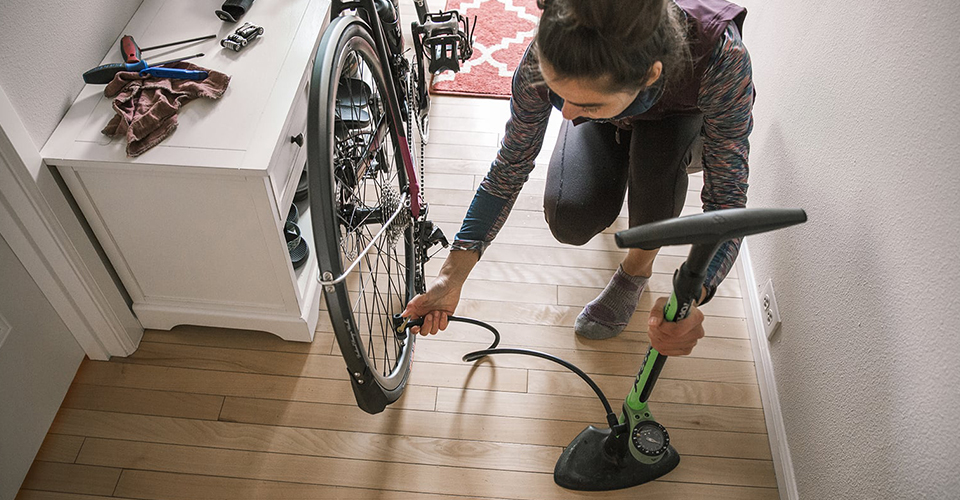 This means even if you forget to put the valve cap back, you don’t have to worry about having a flat tire again after 300 meters down the road.
This means even if you forget to put the valve cap back, you don’t have to worry about having a flat tire again after 300 meters down the road.
As each valve is different, it’s important to make sure they are compatible with the type of pump you have. Because pumps have unique head connections, they are not easily interchangeable with tires that have either a Presta or Schrader valve. Some pumps have dual attachments and fit with both valve types—the smaller one for Presta and the larger one for Schrader.
There are many bicycle tyre pumps for you to choose from, but generally, they fall into two categories.
Floor PumpsFloor pumps are a great tool to keep stored in your garage and maintain your bike at home. They are larger and take fewer strokes to pump up your tires. With a high capacity of 160 up to 200 PSI, they inflate a bike’s tire in a pinch.
Hand PumpsA floor pump has higher capacity and is much easier to use, but you can’t take it with you when riding.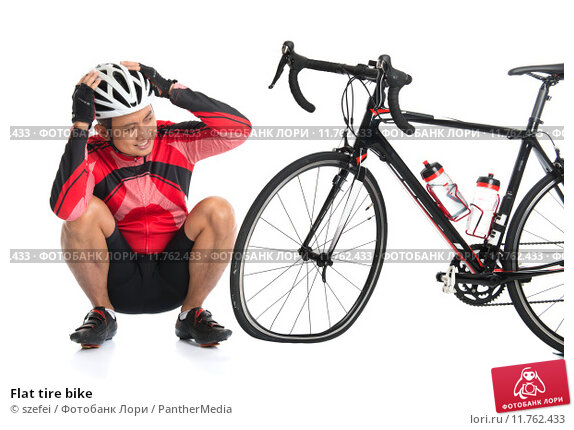 A hand pump, on the other hand, is much smaller, and it fits comfortably in jersey pockets. Although they are limited in PSI and normally take longer and a lot of heavy pumping to fully inflate a tire, they are still perfect for quick trips out.
A hand pump, on the other hand, is much smaller, and it fits comfortably in jersey pockets. Although they are limited in PSI and normally take longer and a lot of heavy pumping to fully inflate a tire, they are still perfect for quick trips out.
Another way to inflate your bike’s tires is by using a CO2 inflator. They contain compressed carbon dioxide and are lifesavers when you need some extra air on the go. They are short-term solutions and not something you’d want to use regularly because they dissipate rather quickly in the span of a single day.
Use the Correct Pounds-per-Square-Inch (PSI)Bike tires should have enough air to function properly, and inflating them to the exact psi requires some finesse. Usually, tires have a minimum and maximum pressure threshold printed on the sides, typically ranging from 25 to 120 PSI, depending on the bike and different terrains. It’s advisable to stick to the manufacturer’s specifications and not go over those limits because they are there for a reason.
By default, your tire should be inflated enough to avert it flattening all the way to the rim or prevent it from completely blowing out. However, there is room to modify the pressure and set it on the amount of pressure that works for you best.
How to Pump Up a Road Bike TireUsually, there’s not much to it—pumping a bike tire is pretty much self-explanatory. But if you’re still confused on how exactly the process goes, follow the steps below:
 If you’re using a floor pump, it’s better to put one foot on each side of the stand. With a hand pump, place one hand firmly on the valve and pump with the other.
If you’re using a floor pump, it’s better to put one foot on each side of the stand. With a hand pump, place one hand firmly on the valve and pump with the other.Voila! Your bike is ready for use. Keep checking the tire pressure, though, as they naturally deflate over time. Keep the PSI on a sweet spot for a smooth and comfortable ride.
by Mike Anderson
themikeanderson
6th July 2015While the majority of you will almost certainly know how to inflate the tyres on your bike, it’s another of those simple tasks, like changing an inner tube or using clipless pedals, that can seem pretty confusing to a beginner.
There are plenty of different types of pumps, inflators, valves, tubes and tyres – and all that can be a real nightmare if you’re coming to it for the first time.
So here’s a handy guide to all things tyre inflation that’ll help to clear up any ambiguity surrounding the subject and have you fully inflated and ready to ride in no time…
The best place to start is what type of valves your inner tube (or tyres, if you’re running tubulars) have. There are two basic types of valves that you’ll find on bikes: Presta and Schrader. For the most part, inner tubes and tubulars on road bikes will use Presta valves, and mountain bikes will use Schrader valves.
The visual differences between the two are obvious, with the Presta (pictured above) being slimmer, lighter and having a lock nut to close that you can see on the top. Schrader valves are wider, more robust and have a spring mechanism on the inside to keep the valve closed, rather than a screwable top section.
Because the widths (or diameters if you prefer, seeing as they’re both cylindrical) are different, they’re not easily interchangeable in wheels that are designed to accept one type.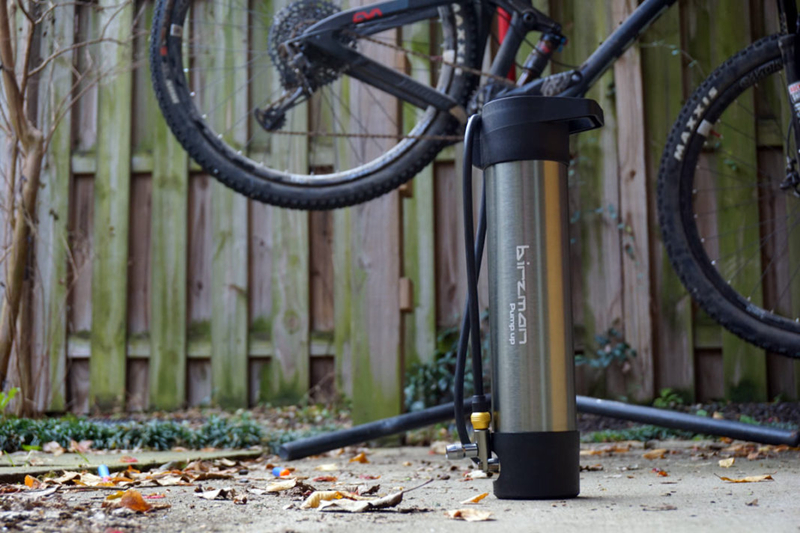
Schrader valves are too thick to fit through the tube hole in a road rim, and Presta valves will need adapters or shims (or an awful lot of electrical tape) to fit on an MTB rim. Plus, in really narrow road tyres, there might not even be space for the large Schrader valve to fit between the beads.
As they have no spring in the valve, Presta valves are easier to pump up than Schrader, especially so with small capacity hand pumps, and it also means small pumps don’t need an in-built device to depress the spring in a Schrader valve.
One of the smart parts of Presta valve design is that even when the top section is open, it won’t leak air unless it’s pressed down. That means even if you forget to rescrew after you’ve pumped the tyre up, you shouldn’t find yourself with a flat again 500 metres down the road.
Because the two valve types are different, they require two different types of head on a pump – or, as is often the case, an interchangeable head.
In other words, you can’t use a Schrader-headed pump to inflate a Presta valve tube without an adapter, and the opposite operation won’t work at all.
Fortunately, most modern floor pumps have a very simple answer for this: a pump head with dual attachments. And that’s even better if you ride both road and mountain bikes, because it means you only need the one pump for both jobs.
The Birzman pump (left) is set up for Presta valves in the picture, but to inflate a Schrader valve you have to unscrew and remove the gold section. But on the PRO pump (right) it’s much easier as there’s a dual head with an ‘s’ at on one side and ‘p’ on the otherSome are very obvious (like the PRO pump on the right of the picture) as there are literally two different attachments on the end of the hose but others (like the Birzman pump pictured left) require you to unscrew the end to reveal the Schrader adapter, or in some cases even flip the valve end over.
It’s still a simple operation but one that can seem completely confusing if you’re just standing there with the valve hose in your hands trying to figure it out.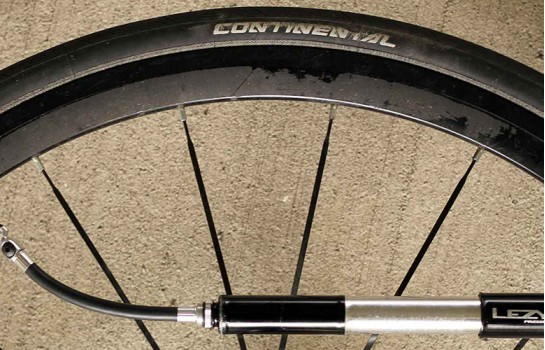
When it comes to actually pumping up your tyres, there are a few different types of pump/ways to do it. The first and most common of these is the track pump. Track pumps are one of those essentials that every cyclist should own.
They’re usually around two feet high, have a fairly large capacity and are capable of inflating tyres to high pressures – usually much higher than required. For example, my track pump can inflate to 160psi which is far higher than I’d ever want my tyres.
Track pumps are quite large and generally kept in the garage (or wherever you keep your bike in the house) to pump up tyres before you ride.
The main bonus is that because of their high capacity, they make inflating tyres to high pressure comparatively easy – you can inflate a tyre all the way up to 100psi in 10-15 strokes easily (depending on pump capacity).
Track pumps are quite large, comparatively, but they’re the best and easiest option to pump your tyres up before a rideThen there’s the mini pump. Mini pumps are ideal to stick in your jersey pocket in case of a mid-ride puncture. Most are capable of inflating tyres to a reasonably high pressure (though not as high as a track pump), but it’s a longer and occasionally more frustrating experience.
Mini pumps are ideal to stick in your jersey pocket in case of a mid-ride puncture. Most are capable of inflating tyres to a reasonably high pressure (though not as high as a track pump), but it’s a longer and occasionally more frustrating experience.
However, no matter how frustrating it’s vastly preferable to being stuck 40 miles from home with a flat and no way of pumping it up.
Mini pumps come in various varieties – some more ‘mini’ than others – and most will have a tube that extends and packs back into the end of the pump in order to add a bit of flexibility without which it would be very easy to snap off the end of a Presta valve. You may laugh, but it can happen.
Mini pumps are ideal for mid-ride puctures. Most have a rubber tube that you can pull out of the pump to add some flexibility and make it easier to inflate tyres on the goThe third common option isn’t strictly a pump, it’s a mini inflator. These use a small valve ending and inflate using disposable CO2 canisters.
The bonus of these is that they inflate incredibly quickly and, depending on the capacity of the canister, can pump a tyre all the way up to around 200psi – not that you’d need to go that high.
The down side is that each canister is single use only, so it’s only as good for as many as you’re prepared to take with you. The SKS Airboy CO2 combines a mini pump and CO2 inflator in one handy unit, which solves that problem.
Mini inflators are a great option for mid-ride punctures. They’re made of two parts – the gas cylinder (on the left) and the head unit (right). But each cylinder is single use only, so you’ll need to carry multiple if you want to be able to inflate more than one tube or tyreThere is one final option, and that’s an air compressor. However, they’re pretty expensive and almost exclusively used by pro team mechanics.
They do make the process an awful lot simpler, and they can also make it easier to hit a desired psi if you have a strong preference. It also saves the pro mechanics from having to pump up 18 individual tyres on the bikes and all the spares every morning at a big race like the Tour de France.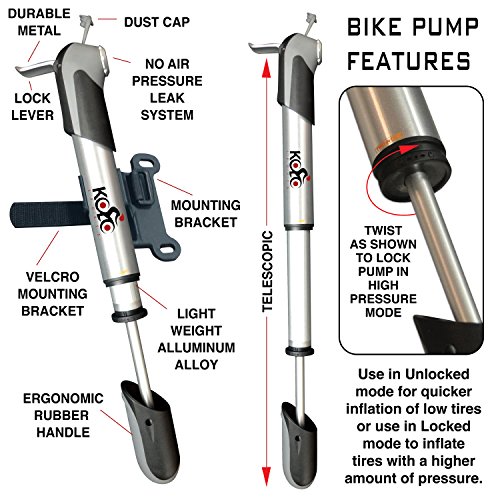
The first step is unscrewing the Presta valve head. It unscrews anti-clockwise and you’ll be able to see it moving upwards along the small central spindle. Make sure it’s open all the way.
Next, attach the pump end to the valve head. As I mentioned earlier, make sure you’re using the Presta attachment on the pump, not the Schrader as otherwise you’ll get precisely nowhere.
Also, you need to ensure the pump head is securely fastened onto the valve otherwise the air won’t go into the tube properly. It needs to be a sealed system to be most effective. How you create that seal depends on the pump. A lot will have a lever you flick up to secure the pump head, some will have a chuck to screw on.
Keep an eye on your track pump’s pressure gauge while you inflate your tyres. If you go over the recommended maximum pressure the results can be drastic, explosive and expensiveAfter that simply pump up the tyre, keeping an eye on the pump’s pressure gauge, and make sure you don’t over-inflate the tyre (most tyres will have written on the side the suggested pressure range).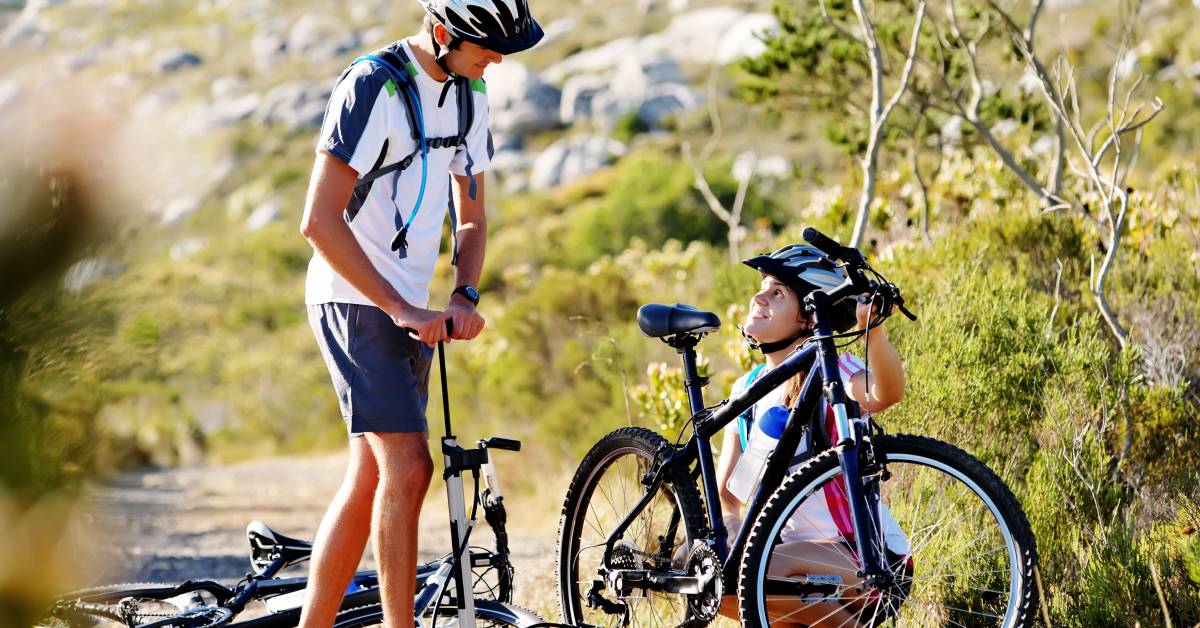
While you might fancy going a little under the bottom number to cushion the ride or add a little more grip, going over the top one could cause the tyre to explode off the rim, potentially writing off the tyre, tube and rim.
Generally you can find a happy medium between the two through experimentation, and depending on your weight, where you ride, and how much cushioning you want the tyre to provide.
And that’s that. Now you’re ready to roll. Simple, right?
Please enter your email so we can keep you updated with news, features and the latest offers. If you are not interested you can unsubscribe at any time. We will never sell your data and you'll only get messages from us and our partners whose products and services we think you'll enjoy.
Read our full Privacy Policy as well as Terms & Conditions.
Cookies help us deliver our services. By using this website, you agree to our use of cookies. Learn More
Accept
production
Hello everyone! In this article, we will tell you how to pump up a wheel on a bicycle. We'll give beginners tips on getting the right tire pressure, talk about different pumps, and cover all the challenges you might run into. Go!
We'll give beginners tips on getting the right tire pressure, talk about different pumps, and cover all the challenges you might run into. Go!
To begin with, let's deal with tire pressure, since a lot depends on it, for example:
Bicycle manufacturers usually list the optimum bead pressure range, which can vary greatly depending on wheel width. For example, for fat bikes, the optimal pressure is from 0.5 to 2 atmospheres, for mountain bikes from 2 to 4 atmospheres. Well, for road models, suitable pressure ranges from 5 to 8 atmospheres.
Based on this, it can be concluded that the minimum pressure is used where it is necessary to ensure good grip on uneven surfaces. Well, the maximum pressure increases the roll on a flat surface. Therefore, we recommend that you inflate the wheels according to how you plan to ride.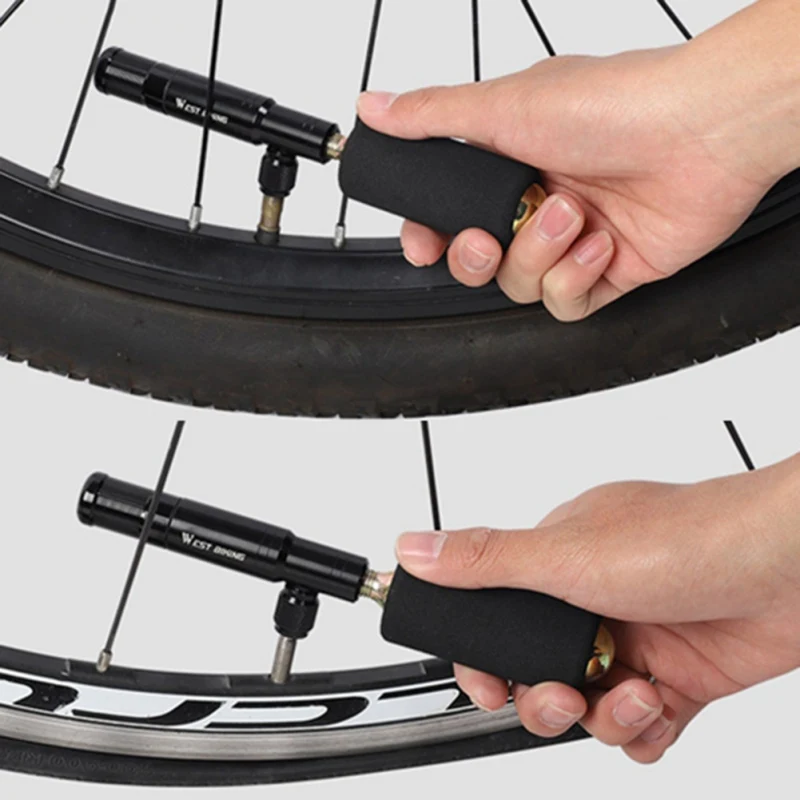 If you don't have a particular preference, inflate at a medium setting for good rolling and traction. nine0003
If you don't have a particular preference, inflate at a medium setting for good rolling and traction. nine0003
The weight of the cyclist should also be taken into account - if you weigh little, then it is better to choose a pressure closer to the minimum, and vice versa.
There are three standards of nipples used on modern bicycles. This is:
Schroeder is the best known type of nipple, which is also used in cars. Therefore, you will meet him on most bikes. nine0003
Presta is a thin nipple often referred to as a French nipple. These nipples are most commonly found on high-end bikes. As for the Dunlop standard nipples, they are very rare.
Some may think that each nipple requires a special pump. But this is not so - it is enough to purchase a regular car pump and an adapter for your type of nipple.
If you don't have a car pump, you can purchase a bicycle pump.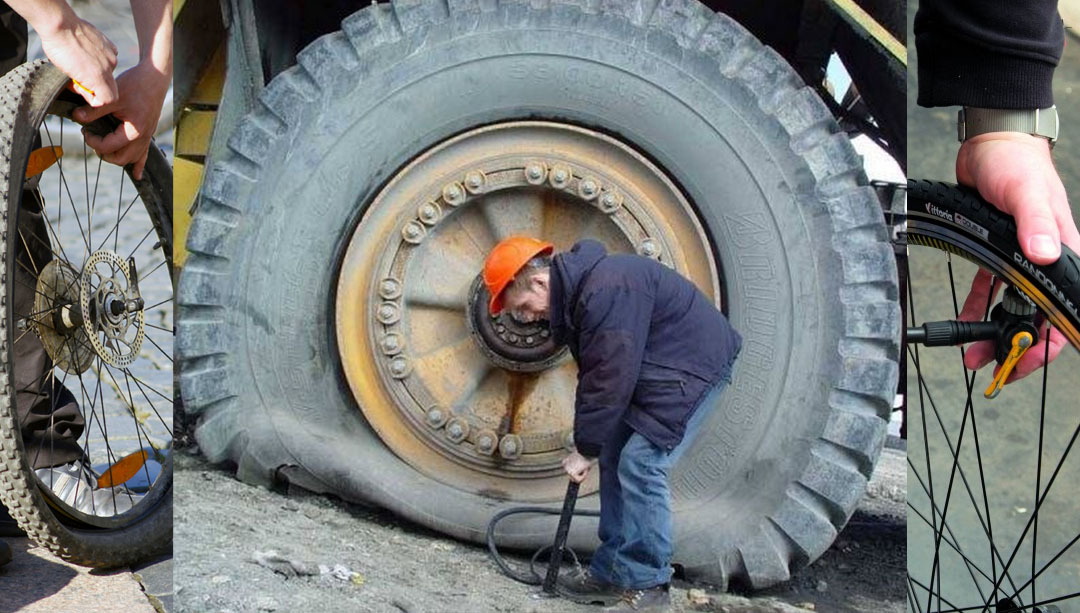 Most of the models on sale are universal, and support all nipple standards at once. Bicycle pumps are:
Most of the models on sale are universal, and support all nipple standards at once. Bicycle pumps are:
Compact pumps pump the wheels for a long time, but they take up little space. They can be mounted directly on the frame, and always carry with you, which is very convenient.
Floor pumps are more comfortable to use as they blow in more air with one push. In addition, they are equipped with a pressure gauge that allows you to control tire pressure. These pumps are an indispensable tool for road bike owners. nine0003
That's all for today. Thank you for your attention, if this article was useful to you, please like us or share it with your friends. See you again.
Who would have thought that inflating road bike tires would be such a nerve-wracking affair?
I swear it wasn't that hard when I was a kid.
You see, after a long break from cycling, I decided to take my bike to work last week.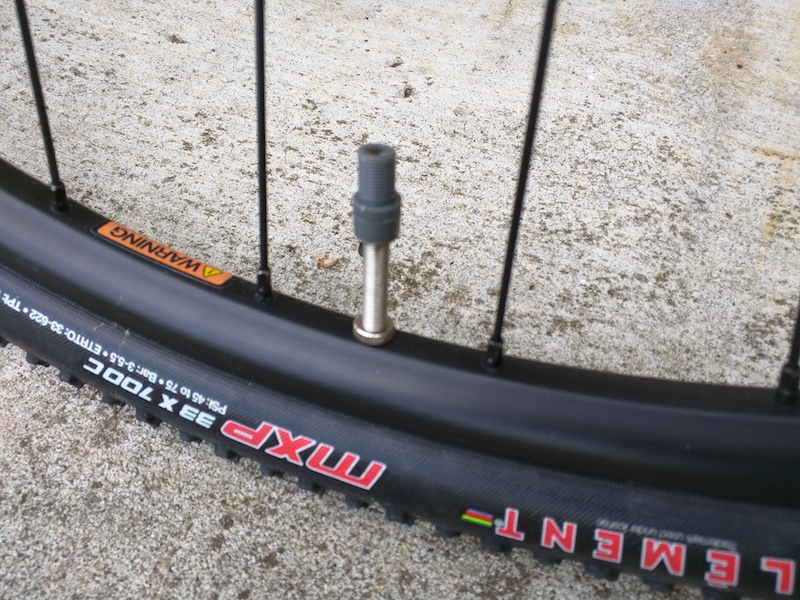 I noticed my tires were low and opened up my new pump for the first time. nine0003
I noticed my tires were low and opened up my new pump for the first time. nine0003
Unfortunately, I was not able to remove the inner screw with my fingers, and with pliers it seemed that I would break it out. I know that many cyclists can understand.
The good news is that my son was there to lend a helping hand before it came to surgery.
And here are the steps we took to pump up my road bike;
1) Selecting the right bicycle pump
Read more!
Here are some of the basic items you need to know about bike pumping.
Valves are ports or connections between the inner tube of the bicycle and the pump. They provide air inlet and outlet.
There are several different types of valves, but the main ones are:
Presta valves are narrower than Schrader valves with a narrow rim bore.
They are also generally longer, making it easier to install the pump.
However, their extra length and lightweight design make them a bit brittle and easier to break.
They are less reliable than Schrader valves and in my years of cycling I have broken a couple of Preston valves more than Schrader valves. nine0003
In addition, they are not compatible with car tire pumps or air pumps at gas stations. For pumping you need an adapter.
But they make up for their short life and incompatibility with gas station pumps by their ease of use.
I prefer the Presta valve to the Schrader valve because it allows for quick and easy opening of the valve.
They do not have a spring in the valve so they are also easier to lower with more positive action. This is especially useful with small capacity hand pumps, as they do not require a built-in spring compressor in the pump. nine0003
Schrader valves are wider and stronger than Presta valves.
They are less likely to break than Presta valves and will last a long time.
They are not as easy to fill as Presta valves. Sure, you can open the valve on the Schrader to let the air out using the tip of a key or your fingernail, but that's just inconvenient.
The smartest part of the Schrader valve is that it has a spring mechanism that keeps the valve closed and air inside. nine0003
This is different from the screw valve on the Presta valve, which means that there is no need to re-screw the valve after inflation, because it will not let air out unless it is pressed down.
What else? Another big advantage of the Schrader valve is compatibility with automotive pumps.
Schrader valves do not require special bicycle pumps. This is useful, especially for beginners who do not yet have a complete set of equipment. nine0003
Both the Schrader valve and the Presta valve have their strengths and weaknesses.
They are also designed to be used on different bike tires, so it's not a question of which is better than the other.
The main thing to remember is that the valves have different widths, so it is not easy to replace one with another.
One wheel can only accept one type of valve.
For example, Schrader valves are thick and difficult to fit into the tube hole on a road bike rim. Conversely, the Presta valve is too thin to fit the tube hole on a mountain bike. nine0003
The Presta valve usually requires an adapter to mount to the MTB rim. But there may not be enough room for a larger Schrader valve to fit on very narrow tires.
The difference in valve types means that the pump heads will also be different.
Simply put, you cannot use Schrader pump heads to fill a Presta valve and vice versa.
You can still use a different pump head for a different valve if you have an adapter. nine0003
Another workaround is to purchase double mount pump heads.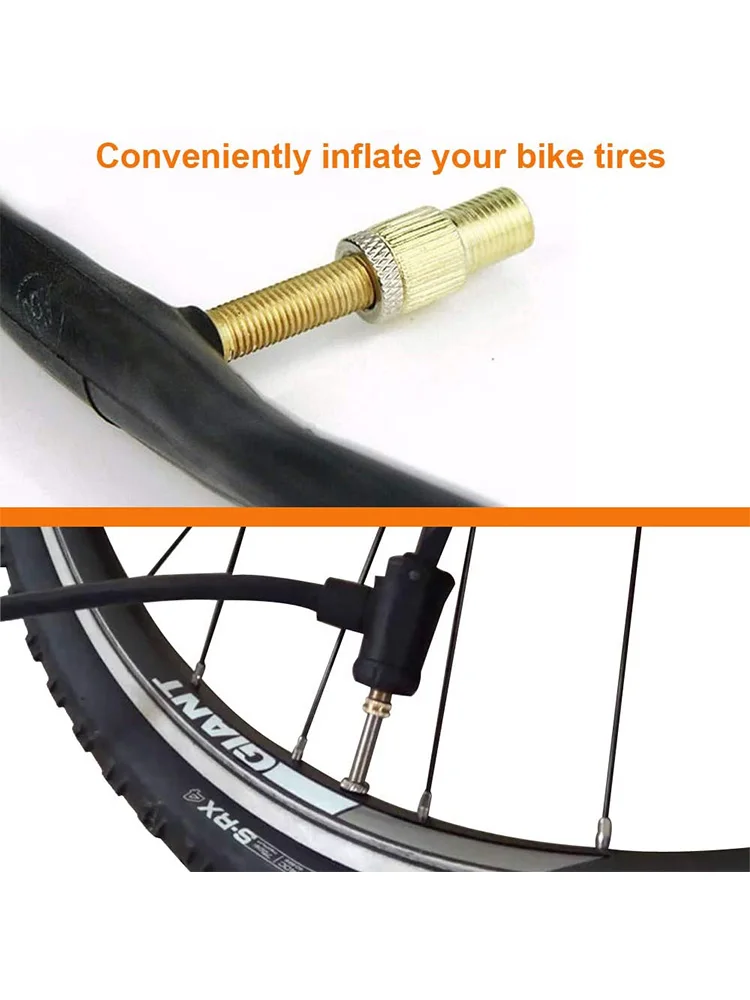
Two nozzle pump heads have a Presta bike tire pump and a Schrader head in one unit.
I'm a big fan of dual mount pump heads considering I have both a road bike and a mountain bike.
This saves me the trouble of having two pump heads or buying an extra adapter.
Finally, we have pump types. They will complete our discussion of the basics of inflating bicycle tires.
As the name suggests, bicycle pumps are tools for pumping air into bicycle tires.
We have different options, but the most popular bicycle pumps:
1) caterpillar pump
2) mini pump
3) Air compressor
4) mini inflator
This is the basic pump that every cyclist should own.
However, floor pumps are bulky, reaching 2 feet in height. The good news is that they have a high inflation capacity, which makes the task of inflating easier and effortless.
Caterpillar pump bike tires save the hassle and eliminate the need for smaller pumps.
And as if that weren't enough, the floor pumps come with great features to make pumping easier. nine0003
For example, mine can support both types of valves. Accessible pump heads can also lock onto the valve so there is no need to worry about air escaping.
In addition, the best bicycle tire pump has an accurate pressure gauge, so it's easy to read the tire pressure.
The only downside to track pumps is that they are bulky and not portable. They are usually stored in the garage and are ideal for those who stay at home.
Mini pumps are a smaller version of track pumps.
These are portable pumps, ideal for those who need to take the pumps with them on their bike rides.
Mini pumps, also known as compact pumps, are small enough to fit in your pocket and come in handy in the event of a flat tire while on the road.
These compact pumps ensure you get home with a puncture rather than being stuck miles away with a puncture and no way to inflate your tires. nine0003
Mini pumps can inflate bicycle tires at high enough pressures, but they are as good as track pumps.
Some elbow grease is required to use the mini pump, but in my opinion I'd rather inflate a tire more than be stuck with a flat tire miles from home.
Our third type of pump is not strictly a bicycle pump.
Mini pump, also known as CO2 pump, uses a CO2 canister to inflate bicycle tires. nine0003
C02 cartridges are typically filled with compressed carbon dioxide for quick, easy and efficient filling.
The main advantage of mini inflatables is that they are ultra-light, so they won't weigh you down on long road bike rides.
Secondly, they are effective at filling bicycle tires and require only a fraction of the effort and time compared to a mini pump or a floor pump.
The biggest disadvantage of mini inflators is that they are disposable and disposable. nine0003
So it only allows you to refill your tires depending on the number of CO2 cartridges you have prepared.
Our final option, the compressor, is rare among casual road cyclists.
Air compressors are expensive and often used exclusively by professional cyclists or team mechanics.
The biggest advantage of compressors is that they make the inflation process quite easy, especially if you plan to inflate to the desired pressure. nine0003
This air pump saves time and makes it easier to inflate multiple bike tires.
Now that we've covered the basics of inflating a bike, let's look at the exact step-by-step details of inflating road bike tires.
The first step is to determine the type of valve that is used on your bike's rim. nine0003
nine0003
The two main types are Presta and Schrader valves.
Once you have identified your bicycle pump, the next step is to select a pump that is compatible with your bicycle valve.
If your pump is not compatible with a particular valve, consider purchasing an adapter.
After confirming the compatibility of the bicycle pump, the next step is to determine the ideal bicycle pressure. nine0003
Proper bicycle tire pressure is critical to avoid bumpy/stiff riding or hard cycling.
I would recommend choosing a bicycle pump that shows accurate tire pressure. This avoids over- or under-inflating your bike.
It is usually easy to determine the correct pressure because most tires have the correct pressure marked on the sidewall. If not, check the exact pressure in the user manual. nine0003
But generally road bikes require higher pressure than mountain bikes. Road bikes need to be stiff enough and minimize ground contact to reduce rolling resistance.
On the other hand, mountain bikes need more ground contact for better traction and overcoming obstacles.
Generally, the recommended pressure range for road bikes is 80-130 psi and mountain bikes require 25-35 psi. nine0003
The dust cap is a convenient addition to the valve port that prevents dirt and debris from entering the valve.
Presta Valve and Schrader have the same plastic cap design.
You just need to unscrew the lock nut and remove the cap.
Be sure to keep your hat in a safe place so you don't lose it. I usually prefer to keep mine in my back pocket. nine0003
After you remove the cap, the next step is to tighten the pump head over the open head.
This is more than just putting it on top, but you will need to turn it clockwise until it fits snugly. A good way to know if it's blocked is to feel the resistance.
However, be careful not to overtighten as you may break the valve.
It is also necessary to re-confirm the correct nozzle (Presta or Schrader valve) by pressing the valve. nine0003
Once the pump head is firmly and securely screwed to the bicycle tire valve, it's time to start pumping.
But not now.
Most bicycle tire pumps have a lever that initiates the inflation or inflation process.
The mechanism and instructions will depend on the type of pump.
But usually most track pumps require you to turn the handle 90 degrees and then push the lever on the top of the pump. nine0003
Then you can start to inflate the tire.
But, as I said, specific instructions will depend on the pump model.
This step is the actual inflation.
Normally the inflation action is to move the lever up and down until the tire is full.
You just need to put the pump between your legs, grab the lever with both hands and start pumping the track pumps. nine0003
nine0003
Conversely, for a hand pump, small pumps or air compressors, hold the nozzle with one hand, pointing it at the nozzle, and pump with the other hand.
If your bicycle tire pump has a pressure gauge, it's easy to determine the correct pressure for your tire.
If not, you can test inflation using your thumbs.
As soon as you inflate and feel that your thumbs can no longer press, the tire is sufficiently inflated. nine0003
However, this is usually not the best method because it can sometimes be misleading. In addition, it will also depend on your physical fitness.
Another thing is that different tires have different pressures. What works for a road bike may not work for a mountain bike.
After pumping is complete, remove the pump from the valve.
Removal is the opposite of pump installation. For example, if you have a pull-up lever, you just need to press it. Plunger pumps may require a few pushes to remove the pump.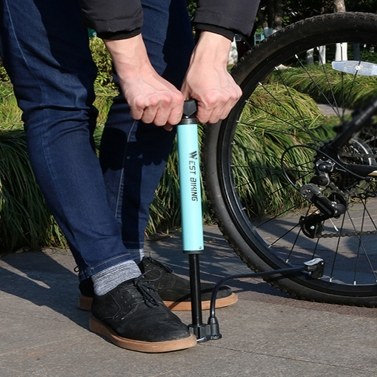 nine0003
nine0003
Remove the valve stem from there.
You may also hear a hiss when the tire is removed. It's excess air, usually in the pump, so it's normal. This will not affect the overall PSI of your tire.
It is easy to check the exact level of tire pressure if you use a digital pressure gauge.
Checking the correct tire pressure and correct tire inflation is especially useful for cyclists who are looking for comfort and excellent driving performance. nine0003
However, it is important to note that different bicycle tire pumps have different scales, so you need to be especially careful.
Another precaution to consider is that dirt and debris on the valve and pressure may affect the accuracy of the dial.
Now, if your bike tire is overinflated, you can relieve the air pressure a little by opening the valve.
If you have a Schrader valve, you just need to press it with a wrench or fingernail to release the air. In the case of a Presta valve, simply open the plastic caps and press the nut. nine0003
In the case of a Presta valve, simply open the plastic caps and press the nut. nine0003
Once you've made sure your tire is inflated to the correct pressure, the next step is to close the valve to prevent air leakage.
If you have a Presta valve, start by screwing in the lock nut until it is tight, then put the cap back on.
With the Schrader valve, you just need to put on the dust cap. It doesn't matter if you leave it open because Schrader pumps don't lose air until the valve spring is pressed. nine0003
But it's always good to have a cap to prevent accidental pressure or getting dirt and other debris on the valve.
Inflating a Presta valve is no different from a Schrader valve.
However, you will need a Presta valved pump.
The key to inflating a Presta valve is the pump head insert.
You start by removing the valve cover and unscrewing the lock nut. The next step is to position and insert the pump head. nine0003
The next step is to position and insert the pump head. nine0003
The hand pump is one of the traditional and popular ways to inflate road bike tires.
It offers a simple and fairly easy way to inflate a tire.
Here is a step by step guide to using the hand pump:
1) The first step is to find a flat and level surface. The tires should be straight and vertical away from you.
2) Attach the pump head to the valve. Make sure the nozzle is securely attached. nine0003
3) Place your hands on the pump handles and start pumping.
Tubeless tires differ from conventional tires in that they do not have inner tubes.
They also don't use traditional bicycle pumps, but instead use air pressure. The inner tube is filled with sealant to prevent punctures while riding.
Here is a step-by-step guide to inflating a tubeless bicycle tire:
1) Purchase an air compressor with an appropriately sized blower head. The inflator head should also have a valve core remover to easily remove the valve stem core.
The inflator head should also have a valve core remover to easily remove the valve stem core.
2) Position the inflator head over the valve of the inner tube. Make sure it is properly aligned for easy screwing in and out of the stem core.
3) Apply pressure to draw enough air.
4) If you feel that the tire has become hard and you can squeeze it more, remove the valve stem core and then remove the pump while holding the compressor firmly with your other hand. nine0003
If you don't have a valve stem remover, a coin or small key can be an ideal replacement.
Proper tire inflation is essential to keep tires from feeling hard or bouncy.
Ideal tire pressure should be between hard rock and spring pressure for optimal performance and comfort.
There are several ways to determine the ideal pressure or how much air you need for your tires. nine0003
You can check the manufacturer's manual.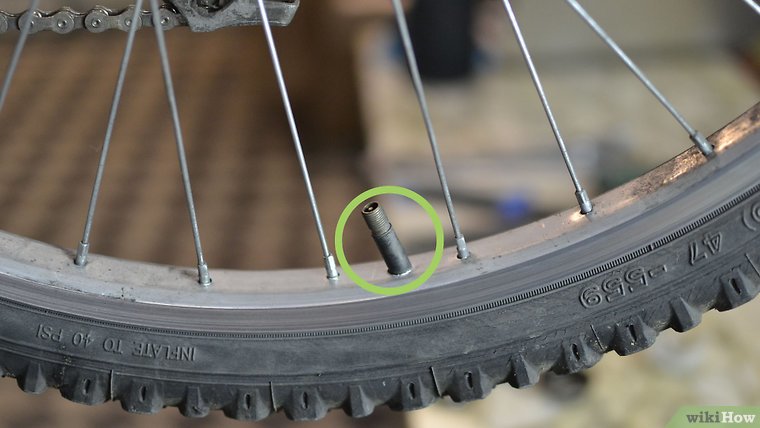 Alternatively, check the pressure with the pump gauge.
Alternatively, check the pressure with the pump gauge.
The last option is crude and involves reading tire pressure with your thumbs.
I am not a big fan of the latter method and I would advise you to find a positive pressure pump with a pressure gauge for accurate pressure readings.
If your tire is under-inflated, you can add enough air until it reaches the correct pressure. nine0003
This will depend on the frequency of use.
However, for most casual riders, you can inflate tires every two weeks.
Proper tire pressure will save you from pinching from time to time.
Proper bike pressure is even more important for racing bikes because it can affect comfort and speed.
The last thing to consider when choosing tire pressure is temperature and environmental conditions. Tire pressure will increase or decrease depending on available temperatures. nine0003
Therefore, always check the pressure after driving for a couple of hours.
This is everything you need to know about inflating a road bike tire.
Make sure all equipment is ready before starting the process. More importantly, make sure your equipment is compatible with your bike system.
Finally, keep your tires inflated correctly. Properly inflated tires are comfortable to ride and optimized for performance. nine0003
Sharing care!
First and last name
Email the address
Text of the appeal
FINANCIAL AND MEDICAL DISCLOSURES
HobbyKraze is a member of the Amazon Services LLC Affiliate Program, an advertising affiliate program designed to provide website owners with the means to earn any advertising fees through advertising and links to amazon.uk a website that may be linked to the Amazon Service. Affiliate Program Ltd. As their partner, we earn on eligible purchases.